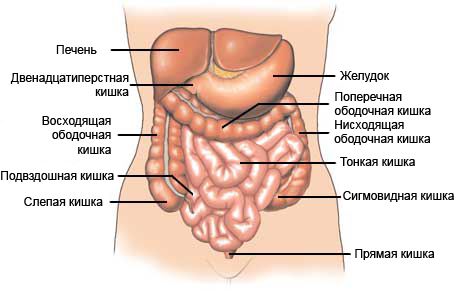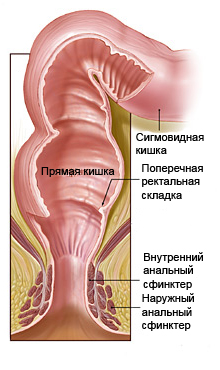Anatomy and physiology of the colon
Colon is the ultimate part of the human digestive system. Its beginning is considered to be the cecum, at the border with a rising Division in the large intestine small intestine empties. Ends with a thick gut outer hole anus. The total length of the entire large intestine in humans is about 2 m. In the colon secrete two parts: colon and rectum the colon.

Colon is such a name because, that she, as rim, encloses the abdominal cavity, located on its periphery. Its length is 1.5-1.75 meters. The colon there are several divisions: cecum, ascending colon, right bending, transverse colon, left bend, descending colon, sigmoid colon.
The transverse and sigmoid obodocnaya guts are bryžejki, where they hang out and attached to the back wall of the abdomen. Therefore, it is characteristic of some mobility, repositioning. Mobile can also be cecum. These divisions are colon in the abdominal cavity and from all sides are covered with special liner-peritoneum.
Other divisions of the colon in normal conditions are fixed on the back wall of the abdomen and covered with peritoneum only in front of the semicircle.
The diameter of the various divisions of the colon varies. In a blind gut and the upward Division he reaches 7-8 centimeters, and in the sigmoid is only 3-4 cm. Around the gut has a lot of ligaments and other entities, restraining her in any position. From the cecum departs vermiform process (appendix), sometimes bringing much misery man.
The wall of the colon consists of four layers. From inside the gut covered with mucous membrane, that has many folds, conducive to digestion and absorption of nutrients. It produces and secretes mucus, that, itself already protects the bowel wall and promotes its contents.
Under the mucous membrane is a layer of fatty tissue (submucosal shell), in which blood and lymphatic vessels.
Further outside is muscle sheath colon. This shell is composed of two layers of: the inner circular and outer longitudinal. Both muscle layers serve an important function, contributing to mixing and promotion of intestinal contents towards the rectum.
Most outer layer of the wall of the colon is the serosa, covering or the entire colon, or only its front semicircle. The thickness of the wall of the colon in its various divisions varies, in the right half of it is only 1-2 mm, and in the sigmoid colon is 5 millimeters.
Rectum is the ultimate Division of the large intestine and has a length of 15-20 cm. It received its name because, that infants actually has direct referral, but later, Once a person starts walking, are the lateral and perednezadnie twists. In the rectum are three Division; perineal (It is also called the anus, anal′nym channel, the anus), ampulârnyj and nadampulârnyj.

Perineal rectal Division has the most complicated structure, and it is here that raises concerns-hemorrhoid patients, cracks, itch, fistulas, etc. The height of this unit is 2.5-3.5 cm. Passive anal′nyj the channel is closed because of a reduction in the surrounding muscles, internal and external muscle sphincters, or žomov.
When a finger rectal study physician determines the tone of the sphincters and their top edge. Here are the prâmokišečnyh Plexus of veins, that can be the basis of Internal hemorrhoids hemorrhoids. On the edge of the outer holes of the anus can be formed external haemorrhoids.
Above the channel anus is located ampulârnyj Division (ampoule) rectum. It has a length of 9-12 inches, Max diameter of the ampule is 8-9 cm, but she can stretch up to a diameter of 15-17 inches. In ampoule kalovoe accumulates the contents; At its mucous membrane there are many longitudinal and three transverse folds. Longitudinal folds in the lower division form the so-called butt plugs bollards, between which are flaps of mucosa.
For specified dampers are perianal sinus, or sinuses. This is a very important education. They accumulated a solid feces, which for constipation and excessive natuživanii during defecation can injure the mucous membrane, that then leads to the development of inflammatory diseases. Besides, in the rectal sinuses are ductless glands, which is able to penetrate the infection, calling development paraproctitis. There are internal holes most fistulas straight intestine.
Line, formed anal′nymi balusters and Sines, is called the dentate line, It is determined by the upper edge of the muscle sphincters.
Nadampulârnyj Division colon length 2.5-4 cm has a narrow lumen, its mucosa consists of transverse folds, above it goes into sigmovidnuû gut.
Rectum in men front predležit to the bladder, seed bubbles, prostate, women — to the uterus and into the back wall of the vagina. Inflammatory processes with these bodies may move to the rectum and vice versa. Behind the rectum evil is present with the sacrum and coccyx, separating from them with a layer of adipose tissue.
Perineum is a part of the body, located around the anus. On this area quite often localized disease, related to rectum (CVIS, acute paraproctitis). Around the rectum is a few spaces, filled with adipose tissue, often develop inflammatory processes.
The function of the large intestine are diverse, but among them there are three main:
- vsasyvatel′naâ;
- rezervuarnaâ;
- èvakuatornaâ.
Absorption in the large intestine is carried out in large volume. From the small intestine into a thick daily runs around 2000 grams of food gruel (chyme), After 200-300 remains suction grams of feces.
The most intensely the process occurs in the right half of the colon. Here is well absorbed water, a small amount of, salts, carbohydrates, fat. In the left half of the colon almost nothing is absorbed (same, as in the rectum), but not because, that the gut mucosa is not capable of this, and because, that has nothing to suck. If a direct or sigmovidnuû colon pour water, then it will be. On this is based the use of nutrient enemas.
Rezervuarnaâ colon function is implementation and retention of faecal masses to breeding them out. This function belongs to the left side of the colon and rectum. When constipation feces accumulates and upstream divisions of the colon. The accumulation of feces in the rectum leads to the feeling of fullness and reflex urge to stool.
Evacuation the contents of the large intestine is carried out due to the progressive reduction of muscles of the bowel wall, These reductions lead to a variety of movements as wall, and the gut, as a result of which kalovoe content moves from the upper to the lower divisions of the colon. Reduce bowel wall has some of its segments are called peristalsis. In the colon can be and antiperistal′tičeskie wave, that promote mixing content and suction of liquids.
Fecal masses move on colon slowly. So, If the intestinal content passes through the small intestine (5 m) for 4-5 hours, the thick (2 m) -for 12-18 hours, that is nearly 6-9 times slower.
The Act of defecation has a very complex physiological mechanism. The main izgonâûŝej force is the contraction of the muscles of the rectum, and auxiliary forces — abdominal wall, Aperture and muscle, When the reduction which is tightened anus. All these muscles should be reduced concurrently with the relaxation of the sphincters of the anus. If there is a violation of coordination between these activities develop constipation or, conversely, incontinence of the contents of the colon.
In addition to these basic functions, colon has the ability to allocate in the lumen of the digestive juice with a small amount of enzymes. From the blood into the lumen of the gut can be salt, alcohol and other substances "which sometimes cause irritation of mucous membrane and the development of such diseases, as proctitis, proctosigmoiditis. This is the same mechanism is irritating to the mucous membranes of the colon and salty foods.
